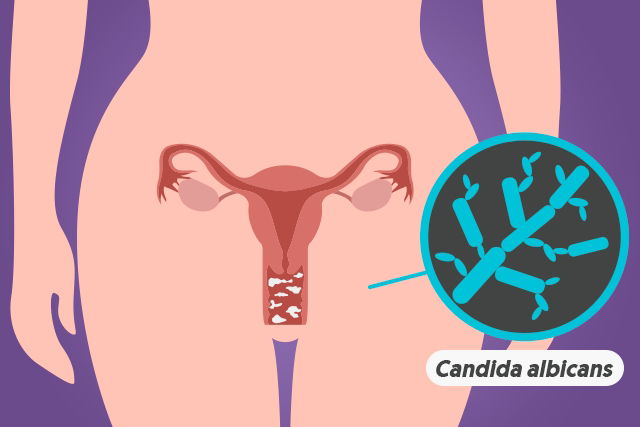Vaginal yeast infections are a very common genital infection in women that are caused by the excessive growth of the Candida albicans fungus. This fungus is naturally found in the genital tract, but can overgrow and lead to symptoms like white discharge, intense itching, swelling or redness in the vulva and/or vagina.
The overgrowth of Candida fungi can be related to hormonal changes (from pregnancy, for example), inadequate hygiene, stress, antibiotics, or a compromised immune system.
Treatment for a vaginal yeast infection is guided by a family doctor or gynecologist, who may prescribe antifungals in the form of ointments, vaginal ovules or pills.

Main symptoms
The main symptoms of a vaginal yeast infection include:
- White, curdled milk-like vaginal discharge with no odor
- Intense itching
- Irritation of the vulva and/or vagina
- Burning sensation
- Swelling in the vulva and/or vagina
- Redness of the intimate region
- Pain or discomfort when urinating
- Pain or burning during sex
Symptoms of a vaginal yeast infection may be more intense before a period, and are generally more intense in cases of acute yeast infections.
Also recommended: White Discharge: 6 Causes & What It Means tuasaude.com/en/white-dischargeOnline symptom checker
Enter your symptoms below to determine whether you may be experiencing a yeast infection:
Please note that this symptoms quiz is only a guidance tool, and does not replace an assessment or a diagnosis from your doctor.
Confirming a diagnosis
A yeast infection is confirmed by your family doctor or gynecologist through an assessment of your symptoms and health history, which is then followed by a pelvic or genital exam.
During the pelvic exam, the doctor may check for signs of inflammation in the vulva and vagina. Usually, the cervix is normal and does not show signs of inflammation.
In some cases, the gynecologist may also order a culture test, which is done by collecting a sample of vaginal secretion to be analyzed in a laboratory. This vaginal swab can confirm the presence of Candida fungus and the specific species, like Candida albicans, Candida glabrata or Candida parapsilosis.
Additionally, a vaginal swab culture can help to rule out other gynecological infections that present with similar symptoms, such as trichomoniasis, bacterial vaginosis, atopic dermatitis, or lichen sclerosus.
Possible causes
A vaginal yeast infection is mainly caused by an imbalance in the vaginal flora, leading to excessive growth of Candida albicans fungus. This fungus is naturally present in the genital tract, but can enter the vaginal mucosa and overgrow, leading to symptoms.
Some factors that can contribute to an imbalance of vaginal flora and the development of a yeast infection include:
- Pregnancy
- Use of birth control pills containing estrogen
- Hormone replacement therapy in menopause
- Stress
- Obesity
- Diabetes mellitus
- HIV infection
- Chemotherapy
- Use of medications such as antibiotics and corticosteroids
- Incorrect cleaning of the anus after evacuation, i.e. from back to front
- Autoimmune diseases
Although they are less common, other species of Candida that can also cause a vaginal yeast infection are Candida glabrata or Candida parapsilosis.
Read more about what causes a yeast infection and how treatment can vary depending on the cause.
Is a vaginal yeast infection a sexually-transmitted infection?
A vaginal yeast infection is not considered to be a sexually transmitted infection (STI), as in most cases it is not related to unprotected sex, but rather, an imbalance in vaginal flora.
However, a yeast infection can be transmitted through vaginal, oral or anal contact, if the partner is infected with the Candida sp. fungus.
Treatment options
Treatment for a vaginal yeast infection should be guided by a gynecologist or family, who may order antifungal medications, like miconazole, tioconazole, nystatin, fluconazole or itraconazole. These can be prescribed in the form of ointments, creams, vaginal ovules or tablets. Check out all the yeast infections creams your doctor may consider prescribing.
Recurring yeast infection, can be treated with fluconazole tablets taken once a week, for at least 6 months.
These medications should be used as prescribed by your doctor for the treatment duration indicated. If you are using ointments, you should avoid sex until treatment is completed.
Read more about yeast infection treatment that is available for different types of yeast infections.
Home remedies
Some home remedies you can use to prevent the recurrence of vaginal yeast infections include:
- Wash and dry the genital area before going to bed
- Wear loose, cotton clothing and underwear
- Include sources of probiotics and lactobacillus in your diet, such as yogurt;
- Sleep without underwear;
Additionally, taking supplements containing lactobacilli is an option to improve the vaginal microbiota and prevent vaginal yeast infections from reappearing.
Also recommended: Yeast Infection Home Remedies: 10 Natural Treatments tuasaude.com/en/home-remedies-for-yeast-infectionYeast infection diet
A great strategy to help speed-up the recovery of a yeast infection is to consume healthy fats, which are naturally found in oilseeds and fish like trout, salmon and herring. Vegetables and whole grains are also important, as they promote optimal intestinal function and strengthen the immune system, which can help lead to a quicker recovery and prevent recurrence.






























